GAME IDENTITY
Cultural Poverty and the Missing Missing Racism
First, I want to say that I already brought up everything in this section to the game's team. I was told that there is an overhaul coming to add more black artwork rather than addressing my ultimate conclusion.
To this, I say that black artwork does not fix the problem in the book. The issue is structural. Black culture is excluded from the game, white culture is prioritized, mechanics and narrative designs are Eurocentric
and the ultimate politics of the narrative focus on the comfort of white people. At least one member of the team that I am aware of is a person of color but no members are black, a statement which I include
because I think it is important to acknowledge this is not an all white team. Although, the majority of playtesters and those involved seem to be white, those who are not white were also involved. Nevertheless,
the game does not address the topic of race at all. Race and cultures outside suburbia America are absent and it gives an uncomfortable feeling to those of us who live outside that paradigm.
We open the book to describe the default setting of the game; the USA's South. The game does not explicitly prevent you from playing in other settings but its assumptions about monsters, guns, vehicles and combat
effectively lock the game to a United States type setting. Further, adding this paragraph here colors the narrative. In mentioning it, the creators have told us that it is important. Therefore, it's fair to include
that the game has the US South in mind when criticizing it.
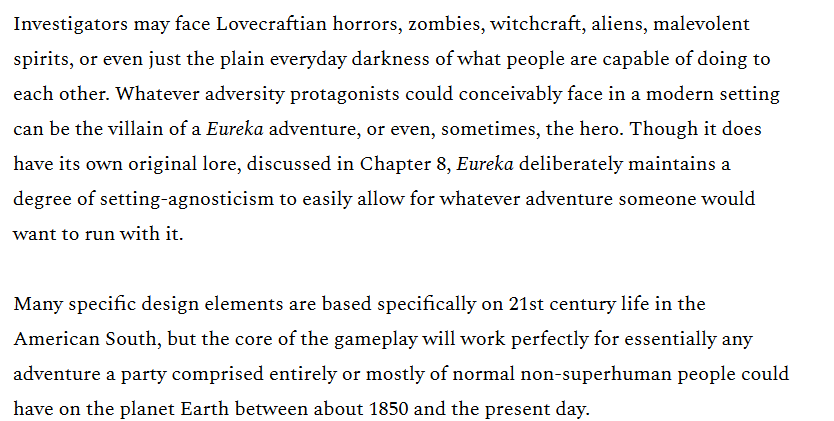
From there, we get a list of media that helped inspire the book. If you're unfamiliar with TTRPGs of this genre, it's fairly typical to include a design statement, with a list of inspirations, like this. It informs
readers on what to expect, what the game values. These inspirations provide context and set the tone. The inspirations for this game include exclusively white led media. Three is no mention of Cleopatra Jones, Shaft,
Get Out, my Sister the Serial Killer, any works by Chester Himes. There are plenty of black written mystery and horror works across all genres from which to draw on inspiration. Many of these works are notable
influences on other white creators, many have won awards, many have been absorbed into the collective cultural unconsciousness. The lack of even a single work shows that black perspectives and culture were not valued
by the development team.
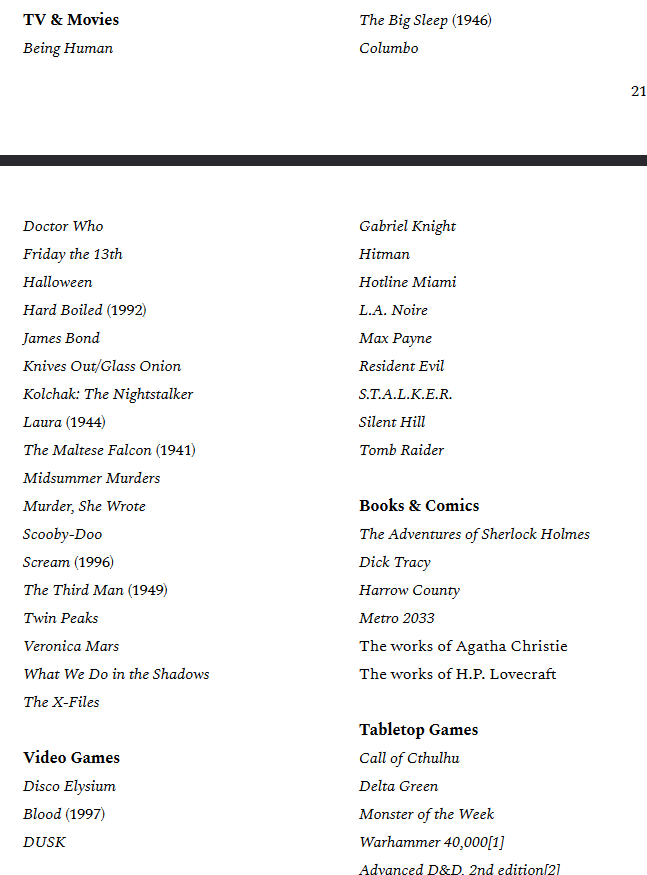
From there, large portions of the book are devoted to the creators' opinions on proper play, what mindset that players should have before getting into the game. One early section is dedicated to separating player
from character and why third person perspective should be used to refer to all PCs and NPCs within the game. Another section speaks on what the roles of players and GMs are, including tips on how to enjoy the
game more. Yet another explains play to lose gameplay in roleplaying games. These authorial intent essays are frequent in the book. At least one is present in every chapter, upwards of five at a time. This particular
section spans sixteen pages of the August edition of the book.
Individually, I have no issue with these clarifications. While I would prefer it if the creators would let players and GMs come to their own conclusions for some of these topics, it is their book and they have a right
to decide how it is played. The issue is in that writing these sections, the authors are now responsible for any mechanical issues that arise from them. If you choose to mention the roles of disabled and queer
PCs and how this affects then and then do not do the same for race, you are telling players that you do not care about racism. If you choose to mention rules for physical disabilites but not mental disabilities, you
are telling mentally ill players you don't care about saneism.
This issue is clearest in the charcter creation chapter. One section is used to explain that Eureka "encourages a great many different types of characters to be made as investigators" and that "we never want players
to fight the rules to play their character". Below that, in the Traits section, a disclaimer explains that all Traits are gender and sexuality inclusive. No similar acknowledgements were made for race. This contradicts
the authors' stated goals of diversity. And because the game mentions diversity, it is fair to judge its lack of it.
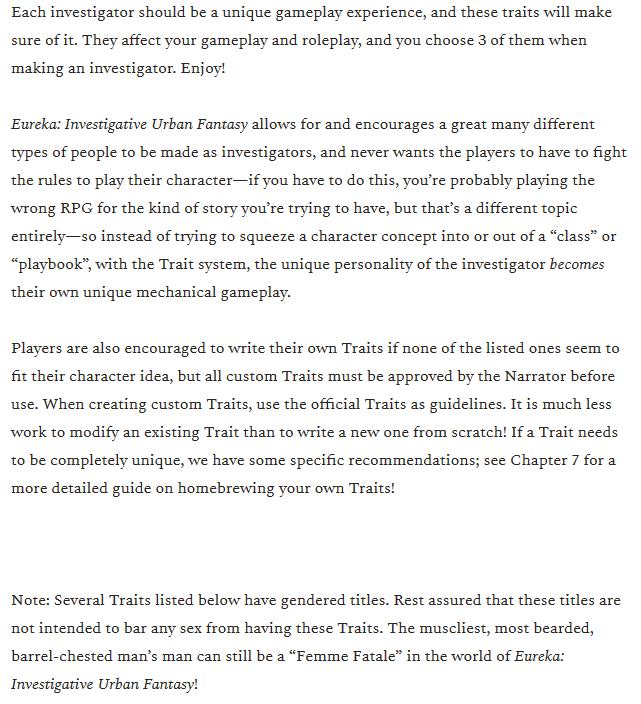
The Traits system itself is a further example of black erasure. The Traits are, predominately, based in USAmerican and Western European tropes. No references to black charcters or black fiction are made. We do not
even have an Afro Detective drawing in this section, who would at least serve to imply that the trait might have been based on a black work even if that isn't really true. Indeed, there is a section in the August
book asking for diversity of the detective drawings when it comes to religious garb. So they clearly are aware that this character can be used to imply marginalization.

The most blatant of this cultural erasure is in the supernatural section. The game's default setting is the US South but the monsters presented in the work are in exclusively European origin and style. While the
game does not prevent you from "homebrewing" your own culture's monsters, a game's quality is based on its rules and setting as presented in the core book. Work that players, GMs or third party sources do are
not counted as "points" either for or against racism. The fact that the authors chose to make a game set in the US South about Western European monsters is an act of erasure. They had the choice to set the game
elsehwere, they had the choice to research other cultures and represent them. They did not. Their solution to offset the labor of this to GMs and players is dishonest and unfair.
The authors are aware that the monsters from Western European history and culture. It is in the text of the monsters' themselves. The vampire is designed with Christianity in mind, with no reference to any of
the syncetric Christian spiritual groups of the United States. Here, the authors' even acknowledge that the vampire does not represent any other culture.
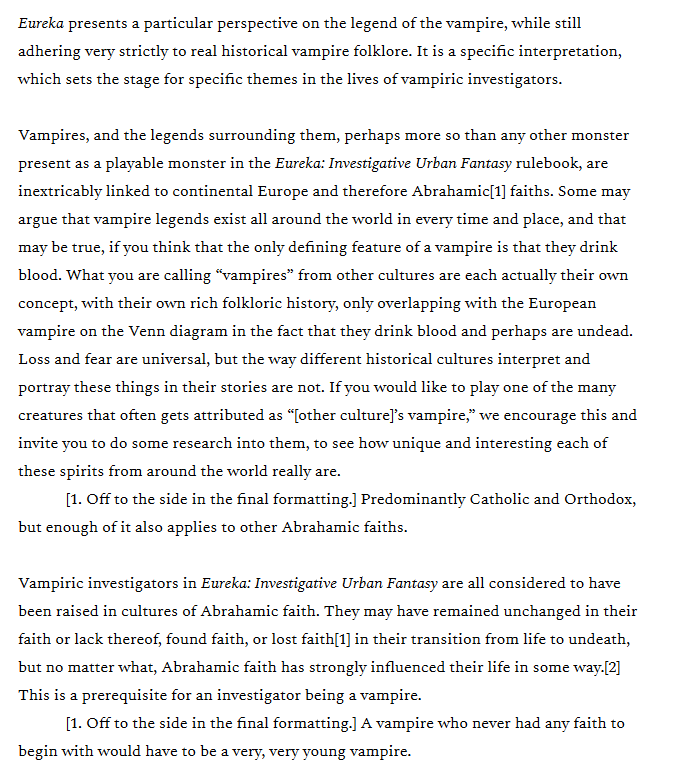
The art further implies that vampires are meant to be white, as the example vampire for the story is a pale, redhaired woman from Europe. Although once again, merely changing the art to be art of a black person
would not resolve the structural issues of erasure. However, the choice of example and the artwork used certainly does not help. Particularly because the narrative says that vampires are the result of deep
regrets and discrimination. If those are the case, why is the vampire a white European and not a slave?
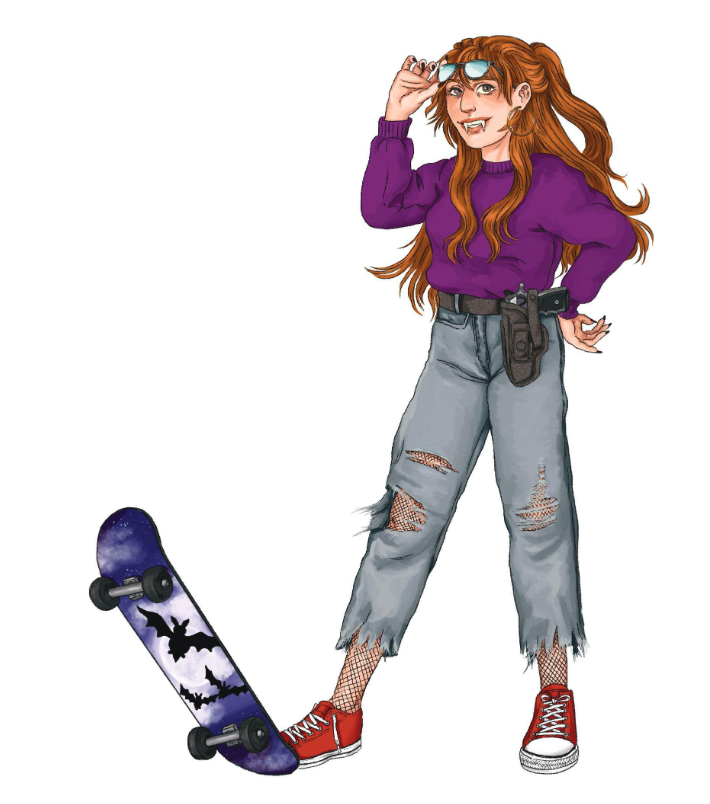
More problematic still is the Fairytale Witch monster. There is a long history in the United States of witchcraft being practiced by black and Chicano peoples of the US. It has been used against us and by us,
as accusations and smears or as reclamations and rituals. For many people, it is deeply tied to their religious practices and their view of the world. This history has been erased by the narrative, in favor of a
Brothers Grimm archetype. The Fairytale Witch is capable of curses so their claims that they do not want to introduce real world religious aspects hold little water. Curses are practiced worldwide, in a variety
of cultures. At the same time, this character is only tenuously connected to European folklore, as their status as a member of a witch family who uses a magic wand bears more resemblance to YA fiction than any
witchcraft tradition.
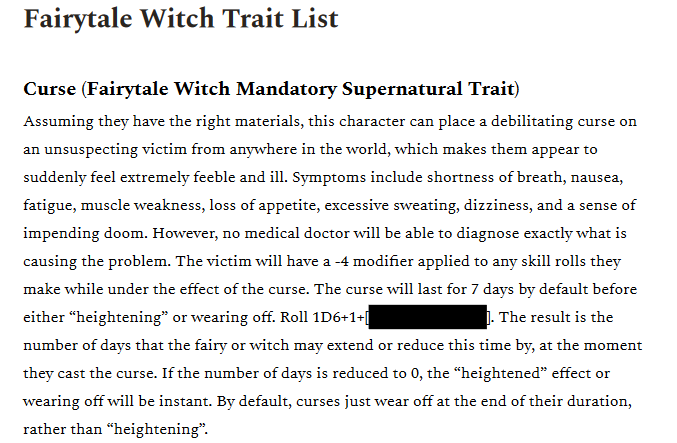
The character that represents this archetype is once again, a pale redhaired woman from Europe.
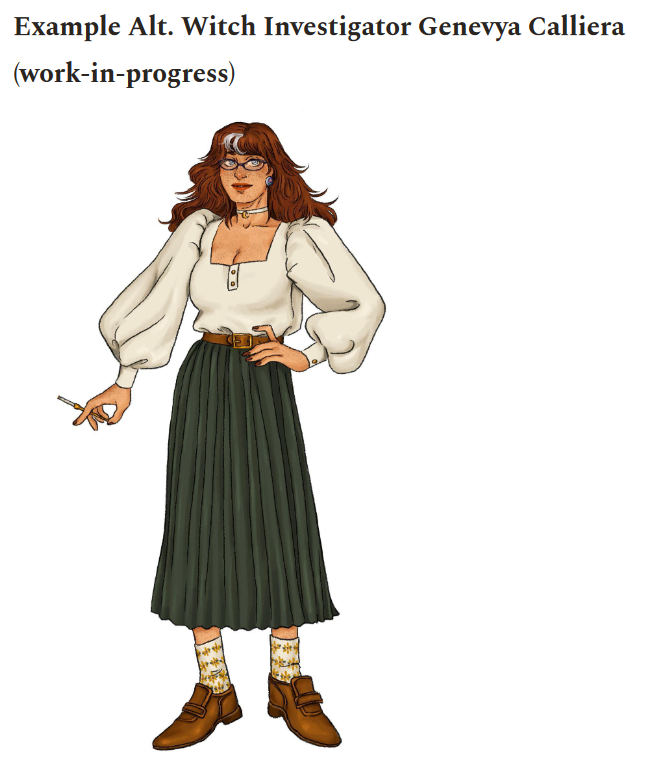
The other monsters are the Werewolf, the Living Doll, The Thing From Beyond (a creature in the style of the Thing), the Gorgon, the Fairy, the Dullahan and the Changeling. There are no ghouls, no zombies and
certainly nothing representing a country beyond Western Europe. While this is a result of the creators' research and interest, I do not see why similar efforts couldn't have been spent in studying the culture
of other countries and people.
Normal is Not Neutral
Whether the creators' intended for this to be the case or not, the default player is expected to be white or at least, not black. The default character is, too. A number of assumptions are made beneath the banners
of "regular", "normal", average" and "reasonable" which again indicate that black perspectives were not considered. There is no universal black mindset, nothing that every black person in the United States (let
alone the entire world) has experienced. But there are certain cultural signifiers that can code a character or narrative as black. What I've listed is merely some of them and my thoughts are colored heavily by
the fact that the game's setting is focused on organized crime within the US south.
The Tiers of Fear omit or downplay several phobias and anxieties that are more common in black people than nonblack people. A paper on the specific phobias and distribution among black people is linked below and
provides some of my reference for this section. Here for further reading. The Tiers of Fear does not list dogs, despite one of the monstrous
character being the "Talking Dog" and another being the "Werewolf", nor does it list mice/rats, police themselves (not just arrests), judges/prosecutors or therapists. There is very little in this section that
describes the relationship between white supremacy, power and fear. Adding two of three of these would have indicated that other perspectives are being considered and coded some of the example characters in
this section as being black.
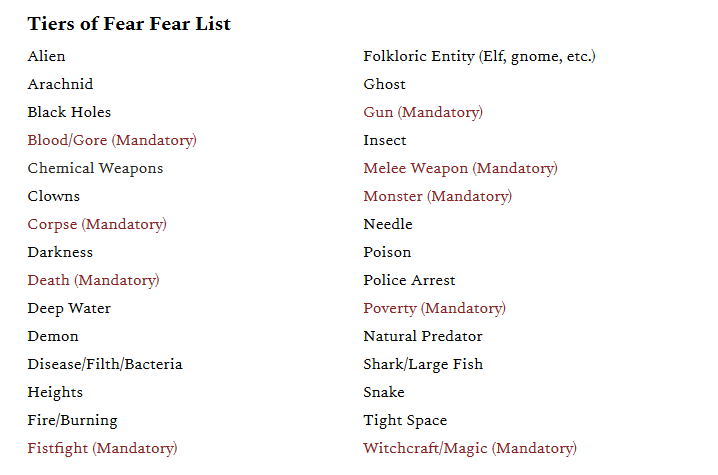
The archetypes this section describes are nonblack in nature as well, usually directly referencing a specific white character. Once again, black cultural references and coding are absent. The characters referenced
in order are Indiana Jones, Shaggy and Scooby Doo and Kolchak the Night Stalker.
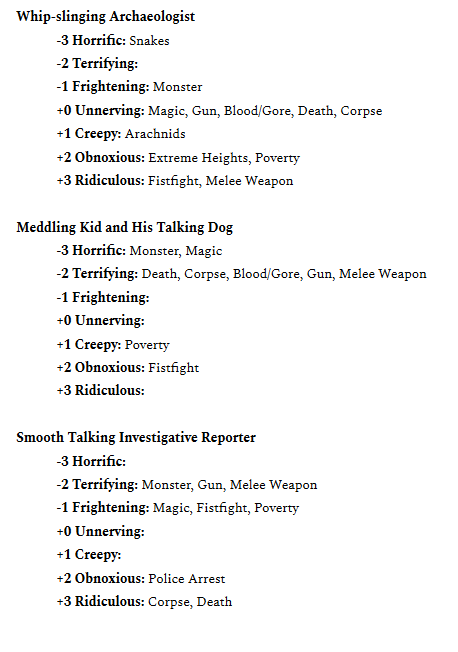
Here, the game also makes the assumption that the characters (and players) default to being afraid of witchcraft, despite many minority ethnic groups having spiritual practices relating to those. This assumption
returns later under a section where we are explicitly told that reasonable people do not believe in magic. I, personally, do believe in otherworldly phenomena. Several of my black and indigenous friends so as
well. Some are even involved in witchcraft communities. This book assumes that people such as myself do not exist or at least, do not play games. If I wrote a passage in a game where I assumed everyone believes
in Christianity by default, people would immediately recognize that as exclusionary. The same should be true for things such as this regarding "witchcraft".
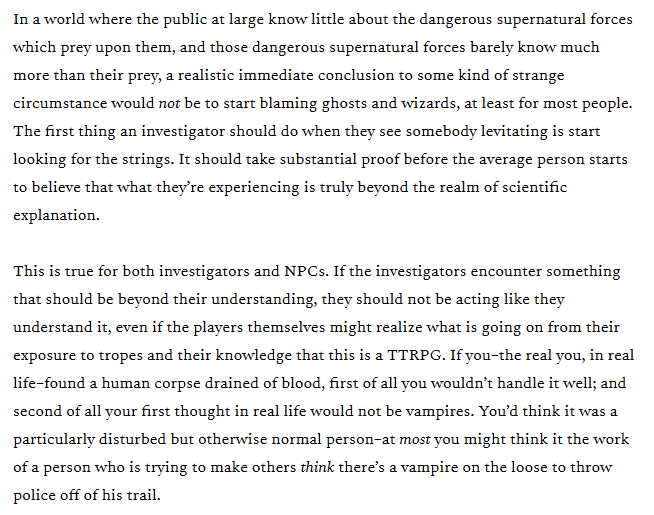
Finally, the game takes a fairly neutral stance towards police and other law enforcement officials. There is lip service paid towards police discrimination, genericized that they target "marginalized people",
but the book never commits one way or the other to whether it supports those agencies. The book's recommendations against playing police officers come from a mechanical direction. Police have sizeable resources
and connections so playing officers would be unfun. On the other hand, FBI characters are frequently referenced throughout the book, positively. While Mulder and Scully never participated in the slandering or
assassination of civil rights leaders on screen, more time is spent on them and other FBI representation than it is on anything involving black culture.
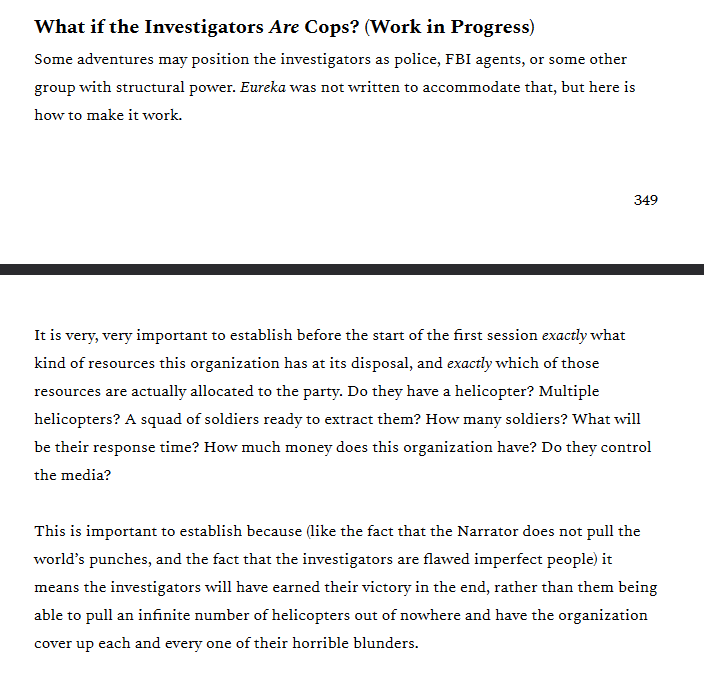
The Monster is a Cultural Body
A monster is a cultural body, standing on the margins. Reflecting what is feared and what is hated, horror is a political work, so naked that it is transparent in how it frames fiction and life. There is a
zombie that spreads disease from person to person, unpredictable and deadly, representing pandemics and a failure of society. There is a zombie which is an ignorant hoard of violence, chasing families into
isolated homesteads and bringing forth a deep, suburban violence, representing immigration and the spectre of gang violence. And there is a zombie that labors all day without rest, who will return to the grave
when reminded of what it loved, representing slavery and freedom. Each one of these narratives tells you what the writers feared, what they loved, what they hoped for. They aren't simply stories. They are
methods of communication.
The monsters in Eureka are metaphors, like all monsters are. This communication is not made through the fiction of the work itself, we are not trusted to do that. Instead, an essay written by one of the authors
explains it to us. This essay tells us that the monsters in Eureka represent disability. Taking more from people than you can give. This is reinforced through their social media marketing, through their brand
identity, through how players are told to play and through their own words. And great care is taken in this. The author is clear and direct in what stories you are and are not allowed to tell.
Monsters are not revengers, they are not to act out of morals but rather, out of a sense of self preservation.
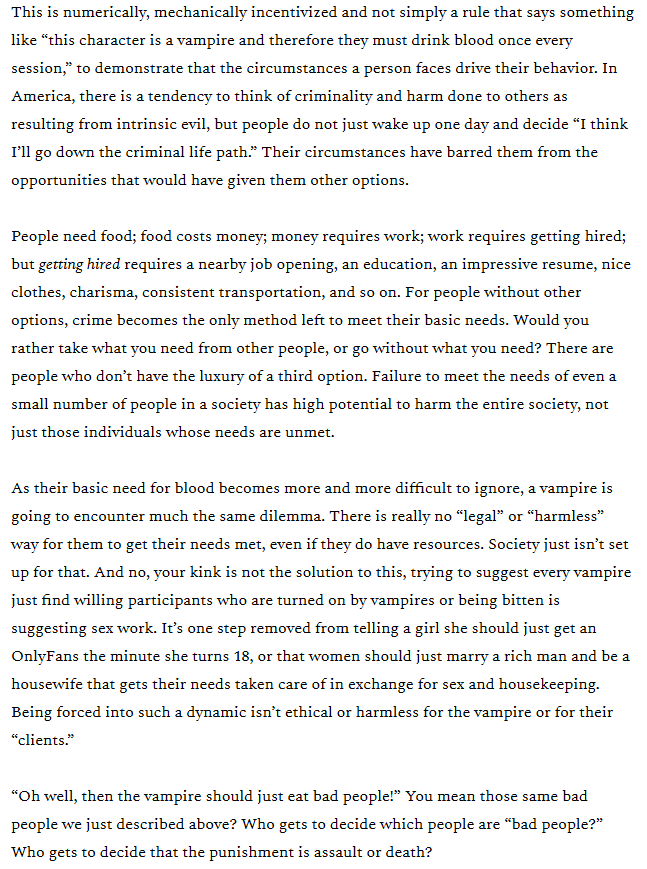
But you can not get rid of them.
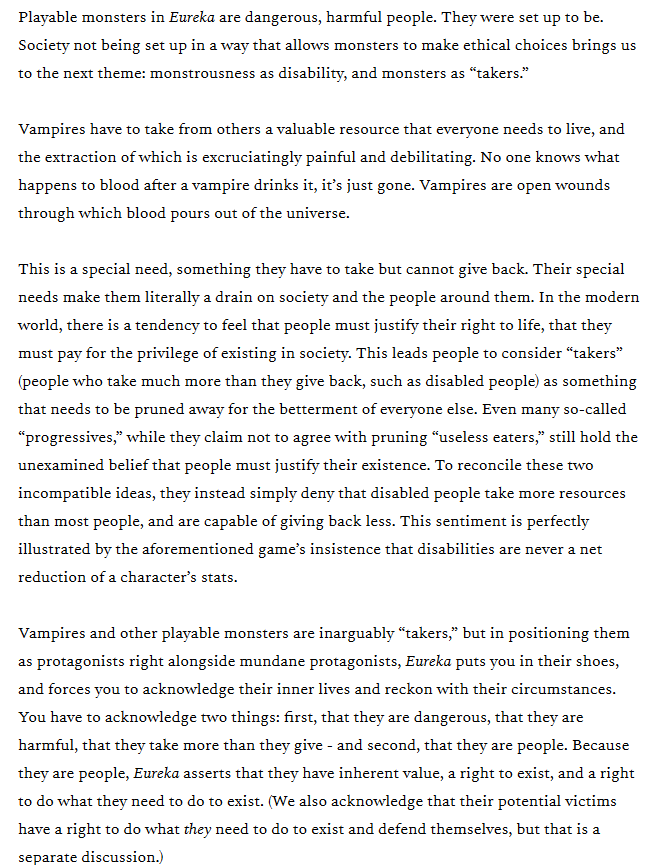
You should not be allowed to get rid of them.
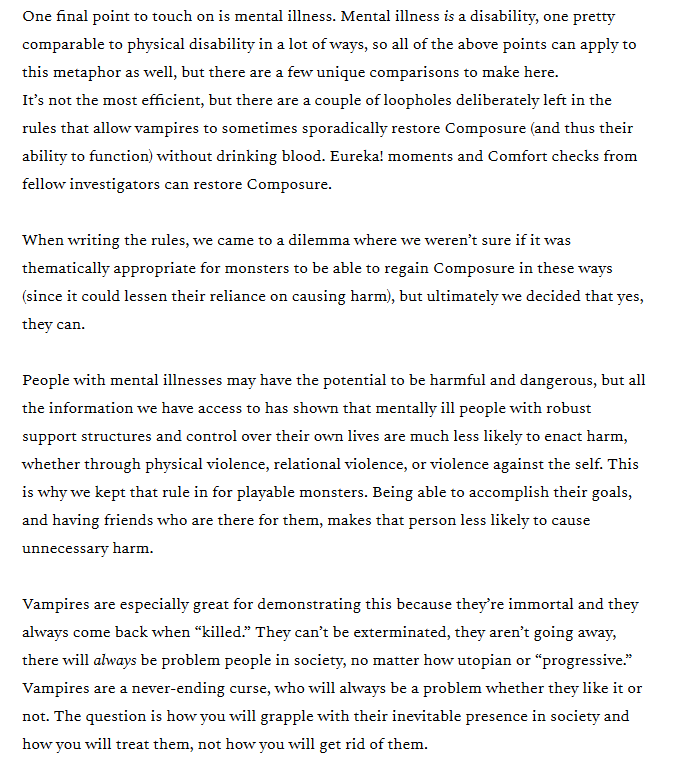
And you can not stop them.
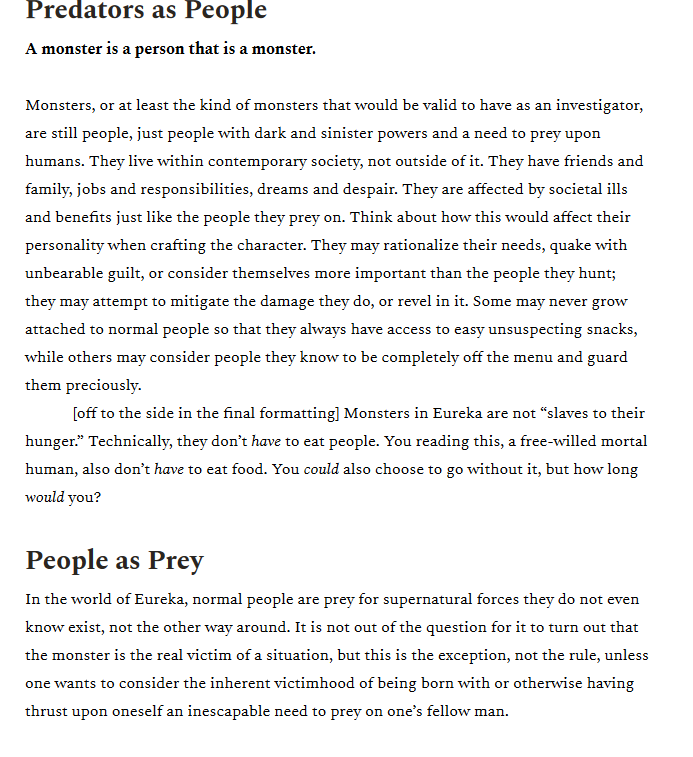
Theoretically, a monster can live off the privileged, they can risk life and limb to attack through iron gates and armed guards. Realistically, they won't. A player's natural inclination is to optimize the game
and mechanically and narratively, a vampire's purpose is to feed off people that nobody will notice have gone missing. The game takes steps to ensure that the best way for a player's monster to live is through
murdering people. Feeding off a willing victim causes the victim substantial harm at the cost of restoring only a single point of Composure. But it goes deeper than that.
In the real world, the majority of disabled people who are able to receive care at all receive it from their peers. Often, other disabled people. Support networks are made out of people who we love, who we
would be agonized to hurt but have no choice but to harm one another because that is how we live. These are the people we hurt. These are the people we "feed" on. Our friends.Were the monsters in this game
explicitly required to feed off their peers, this would be a strong metaphor. But the game doesn't want them to eat their peers. It is described as the least pleasant kind of blood and provides little
mechanical benefits.

At the same time, alternative solutions such as exchanging labor for blood are explicitly called out in the text as being exploitative and coercive. Having to work to eat is what I do in the real world and it
is also exploitative and coercive. If I had the opportunity to not work in exchange for killing people regularly, that would be far more exploitative; to the people that I am killing. In fact, it is a choice
people make every day. They can struggle or they can kill people. They can lose their dignity or they can kill people. They can be happy or they can kill people. These are the decisions that the original colonizers
of this country made before killing millions through genocide and slavery.
Eureka's monsters more accurately represent privilege than marginalization. Rewards are given based on the magnitude of feeding. Killing is encouraged. Hiding one's self, murdering and then merging back into a
peaceful, everyday life is the narrative that Eureka supports. Their victims are irrelevant, forgotten in favor of servicing a narrative of eternal victimization for the vampire, who struggles to process their
heinous crimes and what they've done to survive. The most marginalized of society, sex workers and the homeless, form as their most reliable food. Their victims can not fight against them because the monster
possesses an overwhelming power and can not be killed through any means. Surviving today simply means they will take another victim tomorrow. This is a familiar story.
Consumption of others as a metaphor for whiteness has a long history. White people have been called bloodsuckers and cannibals, leeching of minorities, since imperialism began. The vampiric slave driver is
a well know archetype for a reason. Before imperialism, vampires as heartless aristocrats had a similarly long legacy. Sneaking into beds, they drained people dry, taking everything about them to enrich themselves
as a wealthy person does to the poor. Southern Gothic traded the decaying castles for aging planations, asistrocrats for southern "gentlemen". These stories alluded to racism in an almost fetishistic way.
At the time, white authors focused on the aganst and guilt of these vampiric overlords and the middle class whites who stumbled upon them over the slaves and servants tending to the land. Black writers have
taken our own approaches to the genre, often turning the vampire into an amalgamation of slavery itself, a representation of it that you can destroy.
At times, the consumption of black (and indigeous) bodies was very literal. Treating someone as a commodity is a short jump from treating someone as food. Preparing slaves for field work was called 'seasoning'
and the bodies of slaves were at times, rendered down into medicinal grease. Other times, corpses were left for animals to feed on. Treated like carrion. This cultural baggage follows cannibalism as its shadow;
visible to everyone who has had their blood sucked. The work "Delectable Negro" written by a black, gay author and published posthumously goes into great detail about this relationship.
In Eureka, vampires are obligated to drink. They will starve if they don't. Although this will not kill them, it causes them agonizing pain, similar to that if a human did not eat. Except this pain lasts into
infinity. To me, this makes the metaphor for whiteness only stronger. Whiteness exists in opposition to blackness. In constructing the subhuman, the superhuman is forced, in creating a margin, you create a center.
Without the labor and lives of black people, the white class in this country can't live. This class will collapse under its own weight. Whiteness, as a cultural body, is a prasite. Only through white people starving
this parasite within themselves can this enemy be purged and equality begin to grow.